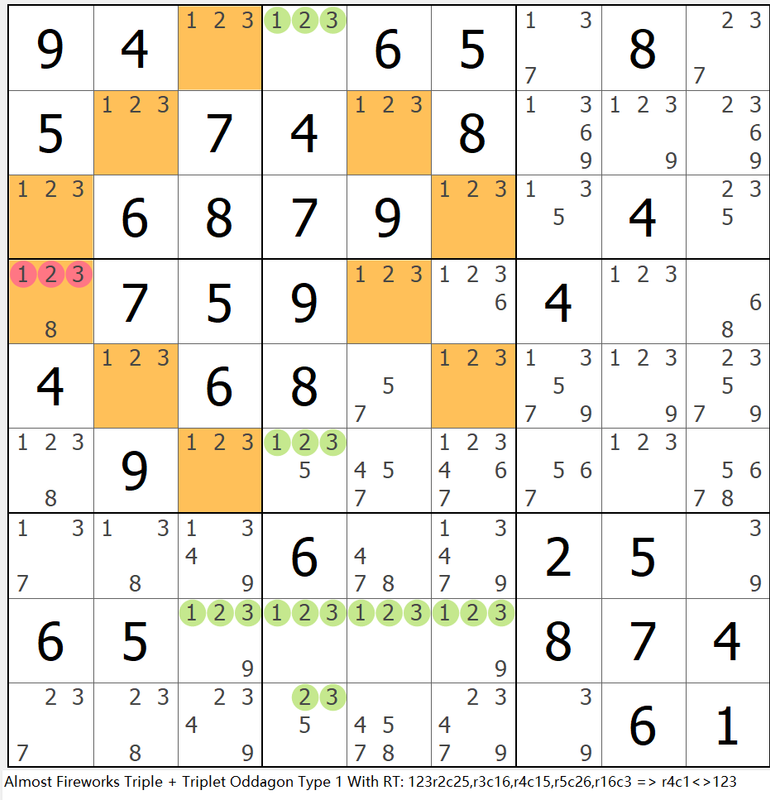.
coloin wrote:Wondering if this is a normal puzzle...
For me, yes: normal among puzzles with a tridagon. It is in T&E(2) with BxB = 9. Generally, such puzzles behave much like T&E(3) puzzles.
- Code: Select all
Resolution state after Singles and whips[1]:
+----------------------+----------------------+----------------------+
! 9 4 123 ! 123 6 5 ! 137 8 237 !
! 5 123 7 ! 4 123 8 ! 1369 1239 2369 !
! 123 6 8 ! 7 9 123 ! 135 4 235 !
+----------------------+----------------------+----------------------+
! 1238 7 5 ! 9 123 1236 ! 4 123 2368 !
! 4 123 6 ! 8 12357 1237 ! 13579 1239 23579 !
! 1238 9 123 ! 1235 123457 123467 ! 13567 123 235678 !
+----------------------+----------------------+----------------------+
! 137 138 1349 ! 6 13478 13479 ! 2 5 39 !
! 6 5 1239 ! 123 123 1239 ! 8 7 4 !
! 237 238 2349 ! 235 234578 23479 ! 39 6 1 !
+----------------------+----------------------+----------------------+
185 candidates.
naked-triplets-in-a-column: c5{r2 r4 r8}{n3 n2 n1} ==> r9c5≠3, r9c5≠2, r7c5≠3, r7c5≠1, r6c5≠3, r6c5≠2, r6c5≠1, r5c5≠3, r5c5≠2, r5c5≠1
Two impossible patterns at work (EL14c30 is the second most frequent one). The EL14c30 pattern is detected at the start, with 6 guardians, but it is used only at the end, after the number of guardians has been reduced to 1 due to several candidate eliminations by other rules.
- Code: Select all
Trid-OR3-relation for digits 1, 2 and 3 in blocks:
b1, with cells (marked #): r1c3, r2c2, r3c1
b2, with cells (marked #): r1c4, r2c5, r3c6
b4, with cells (marked #): r6c3, r5c2, r4c1
b5, with cells (marked #): r6c4, r5c6, r4c5
with 3 guardians (in cells marked @): n8r4c1 n7r5c6 n5r6c4
+----------------------+----------------------+----------------------+
! 9 4 123# ! 123# 6 5 ! 137 8 237 !
! 5 123# 7 ! 4 123# 8 ! 1369 1239 2369 !
! 123# 6 8 ! 7 9 123# ! 135 4 235 !
+----------------------+----------------------+----------------------+
! 1238#@ 7 5 ! 9 123# 1236 ! 4 123 2368 !
! 4 123# 6 ! 8 57 1237#@ ! 13579 1239 23579 !
! 1238 9 123# ! 1235#@ 457 123467 ! 13567 123 235678 !
+----------------------+----------------------+----------------------+
! 137 138 1349 ! 6 478 13479 ! 2 5 39 !
! 6 5 1239 ! 123 123 1239 ! 8 7 4 !
! 237 238 2349 ! 235 4578 23479 ! 39 6 1 !
+----------------------+----------------------+----------------------+
EL14c30s-OR6-relation for digits: 1, 2 and 3
in cells (marked #): (r8c5 r8c3 r4c5 r4c1 r6c6 r6c3 r5c6 r5c2 r2c5 r2c2 r3c6 r3c1 r1c4 r1c3)
with 6 guardians (in cells marked @) : n9r8c3 n8r4c1 n4r6c6 n6r6c6 n7r6c6 n7r5c6
+----------------------------+----------------------------+----------------------------+
! 9 4 123# ! 123# 6 5 ! 137 8 237 !
! 5 123# 7 ! 4 123# 8 ! 1369 1239 2369 !
! 123# 6 8 ! 7 9 123# ! 135 4 235 !
+----------------------------+----------------------------+----------------------------+
! 1238#@ 7 5 ! 9 123# 1236 ! 4 123 2368 !
! 4 123# 6 ! 8 57 1237#@ ! 13579 1239 23579 !
! 1238 9 123# ! 1235 457 123467#@ ! 13567 123 235678 !
+----------------------------+----------------------------+----------------------------+
! 137 138 1349 ! 6 478 13479 ! 2 5 39 !
! 6 5 1239#@ ! 123 123# 1239 ! 8 7 4 !
! 237 238 2349 ! 235 4578 23479 ! 39 6 1 !
+----------------------------+----------------------------+----------------------------+
Trid-OR3-whip[4]: c9n8{r6 r4} - OR3{{n8r4c1 n5r6c4 | n7r5c6}} - b6n7{r5c7 r6c7} - b6n6{r6c7 .} ==> r6c9≠5whip[5]: r5c5{n7 n5} - r6n5{c5 c7} - r6n7{c7 c9} - b6n6{r6c9 r4c9} - c9n8{r4 .} ==> r5c6≠7
At least one candidate of a previous Trid-OR3-relation between candidates n8r4c1 n7r5c6 n5r6c4 has just been eliminated.
There remains a Trid-OR2-relation between candidates: n8r4c1 n5r6c4
At least one candidate of a previous EL14c30s-OR6-relation between candidates n9r8c3 n8r4c1 n4r6c6 n6r6c6 n7r6c6 n7r5c6 has just been eliminated.
There remains an EL14c30s-OR5-relation between candidates: n9r8c3 n8r4c1 n4r6c6 n6r6c6 n7r6c6
Trid-OR2-ctr-whip[5]: r5c5{n7 n5} - r6n5{c5 c7} - r6n6{c7 c9} - c9n8{r6 r4} - OR2{{n5r6c4 n8r4c1 | .}} ==> r6c6≠7At least one candidate of a previous EL14c30s-OR5-relation between candidates n9r8c3 n8r4c1 n4r6c6 n6r6c6 n7r6c6 has just been eliminated.
There remains an EL14c30s-OR4-relation between candidates: n9r8c3 n8r4c1 n4r6c6 n6r6c6
whip[1]: c6n7{r9 .} ==> r7c5≠7, r9c5≠7
whip[5]: c9n8{r4 r6} - b6n6{r6c9 r6c7} - r6n7{c7 c5} - r5c5{n7 n5} - b6n5{r5c7 .} ==> r4c9≠2
whip[5]: c9n8{r4 r6} - b6n6{r6c9 r6c7} - r6n7{c7 c5} - r5c5{n7 n5} - b6n5{r5c7 .} ==> r4c9≠3
EL14c30s-OR4-relation between candidates n9r8c3, n8r4c1, n4r6c6 and n6r6c6
+ same valence for candidates n8r4c1 and n6r6c6 via c-chain[4]: n8r4c1,n8r4c9,n6r4c9,n6r4c6,n6r6c6
==> EL14c30s-OR4-relation can be split into two EL14c30s-OR3-relations with respective lists of guardians:
n9r8c3 n4r6c6 n6r6c6 and n9r8c3 n8r4c1 n4r6c6 .
Trid-OR2-whip[4]: OR2{{n5r6c4 | n8r4c1}} - r4c9{n8 n6} - c6n6{r4 r6} - r6n4{c6 .} ==> r6c5≠5whip[5]: r6n5{c7 c4} - r5c5{n5 n7} - b6n7{r5c7 r6c9} - c9n8{r6 r4} - b6n6{r4c9 .} ==> r6c7≠1
whip[5]: r6n5{c7 c4} - r5c5{n5 n7} - b6n7{r5c7 r6c9} - c9n8{r6 r4} - b6n6{r4c9 .} ==> r6c7≠3
whip[5]: c9n8{r6 r4} - b6n6{r4c9 r6c7} - r6n5{c7 c4} - r5c5{n5 n7} - b6n7{r5c7 .} ==> r6c9≠2
whip[5]: c9n8{r6 r4} - b6n6{r4c9 r6c7} - r6n5{c7 c4} - r5c5{n5 n7} - b6n7{r5c7 .} ==> r6c9≠3
Trid-OR2-whip[5]: c6n6{r6 r4} - r4c9{n6 n8} - OR2{{n8r4c1 | n5r6c4}} - r5c5{n5 n7} - r6c5{n7 .} ==> r6c6≠4singles ==> r6c5=4, r7c5=8, r9c5=5, r5c5=7, r6c4=5, r9c2=8
At least one candidate of a previous EL14c30s-OR3-relation between candidates n9r8c3 n4r6c6 n6r6c6 has just been eliminated.
There remains an EL14c30s-OR2-relation between candidates: n9r8c3 n6r6c6
At least one candidate of a previous EL14c30s-OR3-relation between candidates n9r8c3 n8r4c1 n4r6c6 has just been eliminated.
There remains an EL14c30s-OR2-relation between candidates: n9r8c3 n8r4c1
hidden-pairs-in-a-block: b8{n4 n7}{r7c6 r9c6} ==> r9c6≠9, r9c6≠3, r9c6≠2, r7c6≠9, r7c6≠3, r7c6≠1
hidden-single-in-a-block ==> r8c6=9
At least one candidate of a previous EL14c30s-OR2-relation between candidates n9r8c3 n6r6c6 has just been eliminated.
There remains an EL14c30s-OR1-relation between candidates: n6r6c6
EL14c30s-ORk-relation with only one candidate => r6c6=6The end is trivial, in S2


